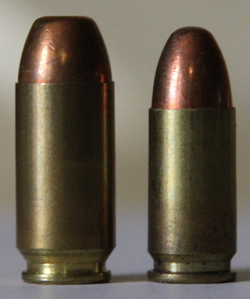History
The .41 Action Express was designed by Evan Whildin, vice president of Action Arms, in 1986. [3] [4] It was based on the .41 Magnum case, cut down to fit in a 9×19mm Parabellum frame, and using a rebated rim.
Performance was compared to the ballistics of the 41 Magnum police load. [2] The .41 AE was thought to be a very attractive concept, as the rebated rim allows a simple change of barrel, mainspring, and magazine to convert many 9mm guns to 41 AE. [2]
The powerful 10mm Auto cartridge, which had been suffering from poor acceptance from its start in the early 1980s, was eventually accepted by the FBI in a reduced power, subsonic loading.
Smith & Wesson then decided the 10mm Auto was too much cartridge for the reduced power loading, and that the .45 ACP sized guns that chambered it were too heavy and bulky; out of this came the .40 S&W, a shortened 10mm Auto case, designed to fit in a 9mm-sized gun, with a reduced pressure loading that allowed a lighter, easier to shoot gun. [5] [6]
Because most ammunition manufacturers backed the .40 S&W, there was little use for the very similar .41 AE, so production of both firearms and ammunition was soon phased out; [2] it was designated as an 'inactive' cartridge by SAAMI in January 2005. [7]
The .41 AE was less commercially successful than the 10mm Auto, and was soon discontinued 15 years later. [8]
The calibre was doomed by circumstance to obscurity, but the concept of using a rebated rim to allow easy cartridge interchangeability was not lost.
The .50 Action Express, developed by Magnum Research for the Desert Eagle pistol, uses a similar rebated rim that is the same diameter as the .44 Magnum. [9]
This allows a caliber change with replacement of just the barrel and magazine.
Ballistics
The .41 AE can be ballistically similar to the .40 S&W, to the point that many reloading manuals suggest using .40 S&W load data in the .41 AE.
Original IMI factory cartridges are much higher powered, approaching 10mm levels, pushing a 170 gr (11.02 g) bullet at 1215 ft/s. The .41AE actually outperforms the .40SW by a significant amount.
Current (April 2018) production cartridges from Reed's Ammunition and Research lists the following:170 grain JHP at 1230fps; 185 grain JHP at 1180fps and 210 grain JHP at 1150fps. Old Speer reloading manuals also list 210gn JHP at 1150fps. The .40 S&W can duplicate this performance.
The .41 AE uses 0.410-inch (10.4 mm) bullets, whereas the .40 S&W uses 0.400-inch (10.2 mm) bullets.
However, as it lacks the backing of ammunition manufacturers in making .410 caliber bullets suited for semiautomatic pistols, the .41 AE has not achieved widespread popularity. [10] [11]
Comparisons with the 9mm
A key feature shared between 9mm and .41 AE is that the Action Express cartridges have rebated rims, which are the same diameter as the less powerful rounds, but the case is wider, providing more capacity and potential for more power.
This allows these pairs of calibers to be used in the same firearm with only a change of the barrel, recoil spring, and magazine. [12]
This page is based on this
Wikipedia article Text is available under the
CC BY-SA 4.0 license; additional terms may apply.
Images, videos and audio are available under their respective licenses.
